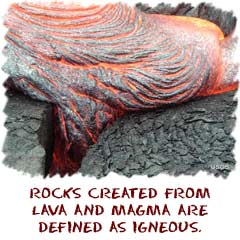Igneous Rocks
Thursday, July 30, 2009 • 7:35 PM • 0 comments
Rocks And Minerals
Let's start off with an explanation that rocks and minerals are different things. Rocks are groups of different minerals pushed together and combined. They don't have easy chemical formulas to describe their makeup. A ruby is considered a mineral. It's a nice pretty crystal with the same compounds throughout the object. But the rock that surrounds that ruby has many many different compounds (and even a few pieces of ruby mixed in). There's an easier example that many people can relate to. Think about quartz. On its own (as a mineral) it's a nice pretty crystal. But a piece of granite often has loads of quartz. It's ground up and crushed, but its still bits of quartz. Granite is a rock and quartz is a mineral.
Igneous Rocks
Igneous rocks are the ones that were superheated and originally liquid. They come from the center of the Earth! Not really the center, but they often start their lives below the crust and then get pumped out. There are two basic types of igneous rocks. There are the rocks that make it to the surface (extrusive) and the ones that are stuck in the crust just below the surface (intrusive). These igneous types have all hardened after being molten rock. If you walk around a volcano, you will find those extrusive types. The intrusive types are usually found in areas called plutons and dikes, big old pools of molten rock that were just beneath the surface. Some examples of igneous rock are granite, all volcanic rock, basalt, and obsidian.xoxo, Mrs. Zayn Malik
One Direction - One Thing♥
Tweet Tweet <3









